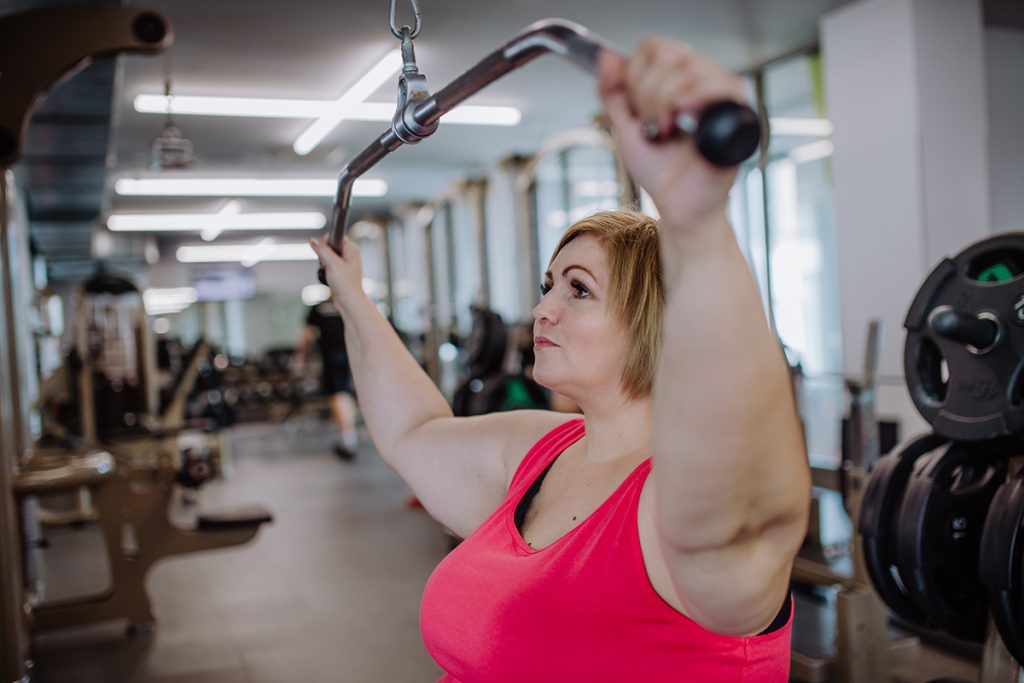Keys to Empowering Women in the Weight Room, Part 2
In Part 1, I reviewed the ACSM study goals, statistics and barriers to weightlifting unique to women
In this article, I’ll cover the three E’s for empowering women in the weight room, and translate these recommendations into strategies that non-professionals can implement for themselves.

1. ENVIRONMENT
Understanding how physical attributes of gyms perpetuate negative messaging regarding women’s bodies and harmful myths about women’s fitness.
- Body image as the sole motivator for exercise with full-length mirrors and posters presenting unrealistic expectations for women’s bodies.
- Insufficient equipment and scaling options.
- An overwhelming male presence and masculine perceptions that can complicate women’s relationship with the gym environment and diminish their confidence to participate.
Overcoming these barriers:
- When considering an environment that is the best fit for you, avoid those spaces with attributes that make you feel uncomfortable. You may prefer a gym with more limited mirror space, and that has a more balanced male/female demographic and female trainers. An example of a more supportive environment is a typical CrossFit “box” where the male-to-female demographic is often split and you will rarely find a mirror.
- Consider a female-only gym space.
- Consider group weightlifting classes. As a former BodyPump instructor, I can vouch for this program as a fantastic way for any beginner to gain confidence with weights and develop a base of sound movement patterns.
- One-on-one training is an excellent way to get personalized instruction on safe weightlifting technique and individualized goal-setting to gain confidence in the basics of weightlifting.
2. EXPERIENCE
People will often gravitate toward their comfort zones and do exercise routines that are more familiar and that are easy to execute.
- Unrealistic expectations for results and timelines to achieve them.
- “Weightlifting is hard.
- Fear of injury or “being sore”.
- “I don’t want to exercise by myself.”
- “I don’t have time to lift weights.”
Overcoming these barriers:
- Focusing on realistic goals of improvements in strength, movement quality, well-being, and specifically for mid-life women, maintenance of bone density and muscle mass to prevent fractures and maintain a healthy metabolism and glucose control.
- Working with a Coach or Trainer to create a personalized program design and dispelling the misconceptions that one needs to spend many hours per week and be sore after every workout to achieve benefits.
- Effective workouts can be achieved in as little as 10-20 minutes provided that the sets, repetitions, and rest periods are programmed accordingly.
- Seek out gym environments that promote small-group weightlifting classes and allow members to bring a guest.

3. EDUCATION
Knowledge is power. Promoting an understanding of the principles of weightlifting and its benefits is key to debunking myths and misconceptions and building a healthy relationship with the barbell.
Common myths and misconceptions about weightlifting:
- Resistance training is less beneficial than cardiovascular exercise.
- Weight training is “dangerous” for women.
- I need to spend hours in the gym to see any benefits.
- Resistance training is not optimal for fat burning.
Overcoming these barriers:
- Seek out opportunities to work one-on-one with experienced trainers who have experience with resistance training in female clients of all ages.
- Take a personal “inventory” of what is most important for you to feel comfortable incorporating weight training into your fitness program and your specific goals. Do you prefer one-on-one instruction? Do you prefer a women-only environment? Is a group setting important to you? Do you have injuries or physical limitations that need to be considered?
- Advocate for yourself. Once you have an idea of what is important for you to succeed, don’t be afraid to ask questions when visiting a facility.
- Do your homework. Read reviews of a facility before you join. Talk to other members. Review the credentials and experiences of the Coaches who work at the facility.
- Seek out reliable sources of information about the benefits of weight training for women as well as safe and effective approaches to the barbell for any level of experience. Here are some of my go-to’s for reliable information:
- MedFit – Menopause Health and Fitness Specialist Course – a 13-hour course focusing on the female experience with the menopause transition, the unique physiology of this life stage and practical application of nutrition and fitness strategies specific to the needs of this population. Fit Pros can earn CEU credit with NASM, ISSA, and canfitpro.
- Dr. Stacy T Sims – blog
- Next Level – by Stacy Sims and Selene Yeager
- CrossFit.com
- Hit Play Not Pause Podcast
- Les Mills BodyPump
- .. and don’t forget the Athletic Aging Monday morning weekly workout series where you will find a treasure trove of resistance training workouts you can do at home (or in the gym) with minimal equipment and modifications for any fitness level.
This is the time of our lives when we need to kick the societal status quo to the curb and take our health and wellness into our own hands and away from destructive narratives. The world is our oyster. We have established our careers, raised our children, and had our share of triumphs and failures. With that comes the wisdom to pave our own way into this new prime of our lives.
So, whether it’s your first back squat with a PVC pipe or a deadlift PR (personal record), congratulations on forging a new frontier to being your fittest, strongest, most vital self!
Dr. Carla DiGirolamo is a double Board-Certified Obstetrician/Gynecologist and Reproductive Endocrinologist who specializes in the care of reproductive age and mid-life women. Carla completed her residency training in Obstetrics and Gynecology at Brown University Medical School/Women and Infants’ Hospital and her Reproductive Endocrinology training at the Massachusetts General Hospital at Harvard Medical School. She is a North American Meno
Fit Pros: Offer menopausal and perimenopausal women an individualized approach to training, nutrition and wellness as a Menopause Health and Fitness Specialist.
References
- Ford, C, Kercher VM, Kercher KA; The 3 E’s – Keys to Empowering Women in the Weight Room. ACSM’s Health & Fitness Journal 27(3):p 14-19, 5/6 2023.
- Harne AJ and Bixby WR. The benefits of and barriers to resistance training among college-age women. Journal of Sport Behavior 19(2):151-66, 2005


